Shuttle XPC M1000 - HTPC Done Right?
by Jarred Walton on October 17, 2005 12:00 PM EST- Posted in
- Systems
Construction and Design
The outward appearance of the M1000 is definitely one of the highlights of this system. It's sleek and attractive, and it will easily fit in with a variety of home theater setups. About the only thing that we'd like is the option to choose a silver enclosure rather than the glossy black, as some people have silver equipment in their entertainment centers. We've taken quite a few pictures of the system from a variety of angles, and we'll provide many of these images throughout the article. However, Shuttle also sent their own images, which were clearly taken in a better environment and with a better camera. You can download all the high resolution Shuttle images in a 15.5 MB Zip file. We'll be using our own images for the most part, and you can also download our complete set of images in a 3.6 MB Zip file.
One of the things that is difficult to convey with online images is the beauty of the case. It has a highly reflective glossy black finish on the top and sides, and our camera and "studio" don't really do it justice. It's almost a shame that most people are likely to have the case hidden away in their entertainment center, but if you have it sitting out where visitors can see it, they'll be sure to cast a few looks of envy at the M1000. The surface, as is typical of high-gloss finishes, will manage to collect fingerprints quite easily, so perhaps hiding it in a stereo console isn't a bad idea if you have little people with grubby hands running about.
While we mentioned earlier that we won't have to worry about system assembly, we still like to "pop the hood" on our hardware. The bottom has two panels that can be removed, with one providing access to the SO-DIMM sockets and the other hiding the CPU and HSF. We didn't bother digging too deep, as getting down to the CPU and RAM sockets really doesn't accomplish much. You can see that the CPU is cooled via a heatpipe design with a small fan to help out. The RAM is DDR PC-2700, which is sufficient, given the lower bus speeds of the Pentium M.
The top panel is secured by four chrome-plated bolts that you'll need an Allen wrench to remove, and there are three additional screws on the rear of the case. Once those are removed, the top slides off and we can get at the internals. We took pictures of the top, left, and right sides to give you an idea of how packed the case is.
The power supply and circuitry is contained in the right side of the case, and the CPU HSF works double duty to provide airflow for both. A black plastic shroud covers the opposite side of the power unit, most likely to prevent contact from shorting something out. The top view shows the HDD and DVDR, as well as the expansion cards. The DVDR is a 4X unit, which is a little outdated, but the slim drive format doesn't have quite as much competition as 5.25" models. Top slim DVDRs now support 8X burn speeds, but for simple backup of TV shows and such, 4X burn speeds will be sufficient. The much smaller drive size is far more important, and noise levels are also lower, which is good for a HTPC unit.
Moving to the expansion slots, you can see the two tuner cards along with the 6600. The close quarters make the 6600 the best choice for such a design, and you certainly wouldn't want to try putting a 6800 or X800 level card into such a confined space. Serious gamers won't be satisfied with the performance level, but the system really isn't designed for such a use. You would also want to replace the keyboard and mouse with something a bit more responsive for gaming - the track ball just isn't going to cut it in most FPS games, unless you have some amazing affinity for such a device.
You might also notice that there's no room inside for further expansion: the single 3.5" HDD bay is filled with a 250GB drive, both PCI slots are full, and so is the X16 PCIe slot. This is a system designed to be sold as a complete unit, and the intended market should be well served by the features.
We mentioned the keyboard and mouse, and you can see the controller here. It's a wireless unit with an integrated trackball on the right side. The two mouse buttons are located on the left side of the keyboard, along with the "Media Center" button - more on that in a minute. Initial use of the keyboard seemed to be good all around the living room, but then range dropped off to around 10 feet after a day or two of testing. (Honestly, I haven't figured out why the keyboard suddenly became less responsive - I may have moved something inadvertently.) The keyboard takes standard AA batteries, with four included. We would guess that the life of the batteries will be at least a couple of months of normal usage, if not more, but an investment in some rechargeable batteries might be a good idea.
The keyboard isn't the only controller, and in fact, for most people, it isn't even the ideal controller. Being a Windows Media Center device, the M1000 also ships with a remote. It takes two AAA batteries and functions on IR, which means line of sight is required. (The IR is actually a Microsoft requirement.) Range is pretty typical (at least 15 feet) and should be fine with the remote, though the IR limitation makes using the remote from a different room essentially impossible. As with the keyboard, notice the MCE button on the remote. This is not a universal remote, so you'll end up with one more remote added to your collection, most likely. (It may be possible to program the functionality into another remote, but we didn't try.)
One last item to mention is the rear panel outputs on the M1000. Most people are used to having multiple 3.5mm jacks for audio output. Some people might have digital audio setups for their PC, in which case they could use S/PDIF optical or coaxial instead. Home theaters, on the other hand, almost never use 3.5mm connections. RCA plugs are the most common, with high-end configurations opting for S/PDIF. Once again showing attention to the target market, the M1000 has standard RCA plugs for the audio output, separated into 8 connections for 7.1 audio. S/PDIF connections are also present, though we weren't able to test those due to the equipment used.
The outward appearance of the M1000 is definitely one of the highlights of this system. It's sleek and attractive, and it will easily fit in with a variety of home theater setups. About the only thing that we'd like is the option to choose a silver enclosure rather than the glossy black, as some people have silver equipment in their entertainment centers. We've taken quite a few pictures of the system from a variety of angles, and we'll provide many of these images throughout the article. However, Shuttle also sent their own images, which were clearly taken in a better environment and with a better camera. You can download all the high resolution Shuttle images in a 15.5 MB Zip file. We'll be using our own images for the most part, and you can also download our complete set of images in a 3.6 MB Zip file.
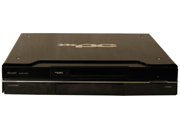 |
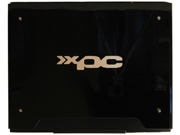 |
| Click to enlarge. | |
One of the things that is difficult to convey with online images is the beauty of the case. It has a highly reflective glossy black finish on the top and sides, and our camera and "studio" don't really do it justice. It's almost a shame that most people are likely to have the case hidden away in their entertainment center, but if you have it sitting out where visitors can see it, they'll be sure to cast a few looks of envy at the M1000. The surface, as is typical of high-gloss finishes, will manage to collect fingerprints quite easily, so perhaps hiding it in a stereo console isn't a bad idea if you have little people with grubby hands running about.
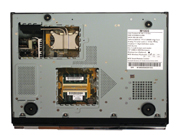 |
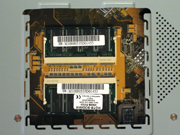 |
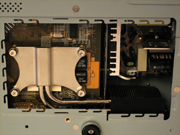 |
| Click to enlarge. | ||
While we mentioned earlier that we won't have to worry about system assembly, we still like to "pop the hood" on our hardware. The bottom has two panels that can be removed, with one providing access to the SO-DIMM sockets and the other hiding the CPU and HSF. We didn't bother digging too deep, as getting down to the CPU and RAM sockets really doesn't accomplish much. You can see that the CPU is cooled via a heatpipe design with a small fan to help out. The RAM is DDR PC-2700, which is sufficient, given the lower bus speeds of the Pentium M.
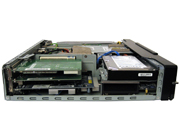 |
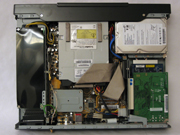 |
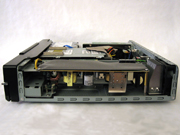 |
| Click to enlarge. | ||
The top panel is secured by four chrome-plated bolts that you'll need an Allen wrench to remove, and there are three additional screws on the rear of the case. Once those are removed, the top slides off and we can get at the internals. We took pictures of the top, left, and right sides to give you an idea of how packed the case is.
The power supply and circuitry is contained in the right side of the case, and the CPU HSF works double duty to provide airflow for both. A black plastic shroud covers the opposite side of the power unit, most likely to prevent contact from shorting something out. The top view shows the HDD and DVDR, as well as the expansion cards. The DVDR is a 4X unit, which is a little outdated, but the slim drive format doesn't have quite as much competition as 5.25" models. Top slim DVDRs now support 8X burn speeds, but for simple backup of TV shows and such, 4X burn speeds will be sufficient. The much smaller drive size is far more important, and noise levels are also lower, which is good for a HTPC unit.
Moving to the expansion slots, you can see the two tuner cards along with the 6600. The close quarters make the 6600 the best choice for such a design, and you certainly wouldn't want to try putting a 6800 or X800 level card into such a confined space. Serious gamers won't be satisfied with the performance level, but the system really isn't designed for such a use. You would also want to replace the keyboard and mouse with something a bit more responsive for gaming - the track ball just isn't going to cut it in most FPS games, unless you have some amazing affinity for such a device.
You might also notice that there's no room inside for further expansion: the single 3.5" HDD bay is filled with a 250GB drive, both PCI slots are full, and so is the X16 PCIe slot. This is a system designed to be sold as a complete unit, and the intended market should be well served by the features.
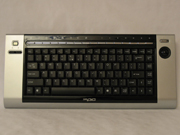 |
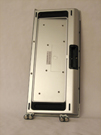 |
| Click to enlarge. | |
We mentioned the keyboard and mouse, and you can see the controller here. It's a wireless unit with an integrated trackball on the right side. The two mouse buttons are located on the left side of the keyboard, along with the "Media Center" button - more on that in a minute. Initial use of the keyboard seemed to be good all around the living room, but then range dropped off to around 10 feet after a day or two of testing. (Honestly, I haven't figured out why the keyboard suddenly became less responsive - I may have moved something inadvertently.) The keyboard takes standard AA batteries, with four included. We would guess that the life of the batteries will be at least a couple of months of normal usage, if not more, but an investment in some rechargeable batteries might be a good idea.
 |
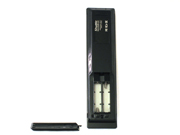 |
| Click to enlarge. | |
The keyboard isn't the only controller, and in fact, for most people, it isn't even the ideal controller. Being a Windows Media Center device, the M1000 also ships with a remote. It takes two AAA batteries and functions on IR, which means line of sight is required. (The IR is actually a Microsoft requirement.) Range is pretty typical (at least 15 feet) and should be fine with the remote, though the IR limitation makes using the remote from a different room essentially impossible. As with the keyboard, notice the MCE button on the remote. This is not a universal remote, so you'll end up with one more remote added to your collection, most likely. (It may be possible to program the functionality into another remote, but we didn't try.)
One last item to mention is the rear panel outputs on the M1000. Most people are used to having multiple 3.5mm jacks for audio output. Some people might have digital audio setups for their PC, in which case they could use S/PDIF optical or coaxial instead. Home theaters, on the other hand, almost never use 3.5mm connections. RCA plugs are the most common, with high-end configurations opting for S/PDIF. Once again showing attention to the target market, the M1000 has standard RCA plugs for the audio output, separated into 8 connections for 7.1 audio. S/PDIF connections are also present, though we weren't able to test those due to the equipment used.


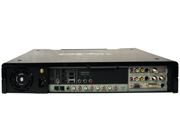








35 Comments
View All Comments
jamawass - Monday, October 17, 2005 - link
In all fairness this is not limited to the Shuttle/ Win XP MCE. I had the same problem with the PVR cable box from TimeWarner Cable. The game lasted about 4 hrs and the tivo only recorded 3 1/2 hrs that was on the schedule so I missed the "fake spike" play too as I couldn't watch the game live. Poor software programming as TitanTV doesn't do that with my winfast pvr card on my pc.
dr_wily - Monday, October 17, 2005 - link
"watts measured at outlet"how is that accomplished?
JarredWalton - Monday, October 17, 2005 - link
"Kill A Watt" device plugged into the outlet, with the M1000 plugged into that. The Kill A Watt is what most of us use for power testing. You can get them online for about $40 I think.agent2099 - Monday, October 17, 2005 - link
I'm suprised Shuttle did not use HDTV Tuners. That would make a device like this actually make sense.I was sure they would use something like 2 AVERTVHD MCE A180 Tuners instead of 2 analogue tuners.
glennpratt - Monday, October 17, 2005 - link
What they should do is make one for Turion with the nVidia 6150 and use three PCI ports. One dual tuner NVTV and two HD AverMedia M180'sBigLan - Monday, October 17, 2005 - link
MCE reuires that there is at least 1 SDTV tuner before you can adda HDTV tuner (don't ask me why though!.) At least with the newly-announced Fusion USB HDTV tuner you could add to this box.agent2099 - Monday, October 17, 2005 - link
In that case it should use one SD tuner and one HD Tuner.Kishkumen - Monday, October 17, 2005 - link
Having another black box sitting on top of a DVD player, sitting on top of your receiver, sitting on top of xyz single function device seems so old fashioned to me. I don't see an appliance such as this really having a place in my future home theater. The way I see it, the backend needs to be little more than a massive storage server placed out of sight like a basement with a terminal interface that contains tuners for all your inputs, over the air, cable, satellite, etc. The heavy lifting would be done by the remote frontends. The computers driving the frontends should not be seen as well and they should be capable of handling HDTV resoluations and all audio duties. I can see this being feasible with Apple's Mac Minis at some point very soon. Velcro the suckers to the back of a flat panel and you've got a very clean looking setup. In such a setup, you would have a Mac Mini driving your largest flat panel for your Home Theater, one in your kitchen, one in your bedroom and so on, each sharing the large repository of resources in your basement. I've achieved this to a certain degree using MythTV. I have a regular Shuttle XPC doing the gruntwork for my home theater, an actual Mac Mini driving a display in my kitchen (although it's underpowered for HDTV), an older Athlon XP in my bedroom and my study computer doubling as a remote frontend as well. Not perfect, but I'll get there. Oh yeah, and Windoze zombies need not apply.glennpratt - Monday, October 17, 2005 - link
You do realize this plays DVD's so you don't need a DVD player? Ever seen MCE Extenders? Everything you discuss is possible with extenders (and there cheaper then a Mac mini). Put a nice MCE box in the basement, extenders on the displays. HD extenders aren't out yet, but the Xbox 360 is coming in Nov. 22 and includes an HD capable MCE Extender (and it's cheaper then a Mac Mini in both forms).This thing does support HDTV, it just doesn't officially support HDTV from cable providers (which noone does). In fact it supports two SD tuners and two HD tuners for a total of 4 tuners.
It WILL however, change channels and record SD and HDTV from the firewire out on many popular cable and DirecTV boxes with firewire using a free plugin.
Windoze... what's that?
JarredWalton - Monday, October 17, 2005 - link
Technically, MCE supports HDTV tuners, but the M1000 as shipped only has two PCI slots and they're filled with SD tuners already.